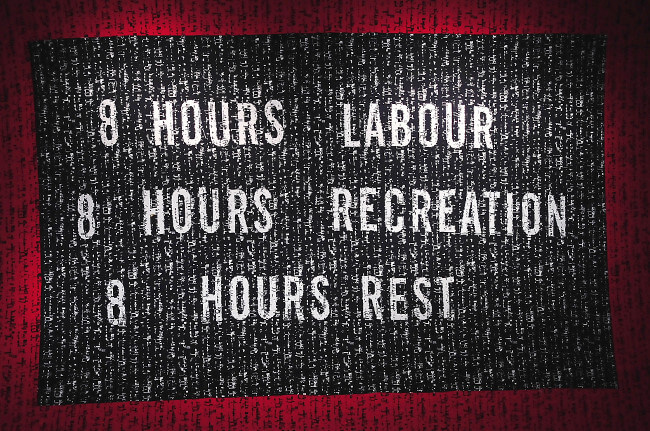A 2014 Gallup poll shows Americans work an average of 47 hours per week. But should the work week be 30 hours? And should this is considered full-time employment? Why should this be done and what are the implications?
Let’s proceed with the understanding that productivity is the measure of GDP divided by hours worked. Productivity is up, way up. An excellent article by Erik Rauch shows that productivity has steadily increased over the last 50 years. According to Rauch, a worker in 2003 matched the productivity of a 1950’s forty hour worker in only 11 hours.
An initial reaction to such a statistic is that the average worker ought to be earning more. But productivity and compensation do not rise together. A 2011 article in the Monthly Labor Review by Susan Fleck, John Glaser and Shawn Sprague, shows that compensation and productivity were on a parallel upward trend until 1981. This became a point of separation when productivity tilted upward while compensation remained flat. Thus, corporate income has increased while worker compensation has not. It does not take a lot of thought to recognize where the additional income has landed.
With the ability to produce more, with fewer labor hours, employers have not chosen to increase pay or to reduce hours. Instead, business has chosen increased profits. It is the natural rub between business and labor, where should the profits go? One place it could go is toward a shorter work day.
If workers had a six hour work day, and a thirty hour week was considered full-time employment, it would reduce the work week of current workers by ten hours a week. This would have to be made up by hiring additional workers. The last thirty five years have shown that there is no consideration that higher wages will be offered as compensation for the increased productivity. Despite frequent pleas for higher wages, activists have met stiff resistance when calling for higher wages as a result of increased productivity. Instead, labor should focus on reducing the work week.
Labor has run a difficult gauntlet to reach a 40 hour work week. The early 1800’s witnessed a series of actions by organized labor as well as workers not aligned with an association, aimed at reducing the then standard 12 hour day. In 1825 carpenters in Boston struck unsuccessfully for a ten hour day. Two years later, carpenters in Philadelphia struck for ten days in another unsuccessful effort to reduce hours. Finally, in 1830, the carpenters combined with bricklayers to demand a ten hour day, this time with success.
In Pennsylvania, the movement was particularly strong. Between 1827 and 1835, twenty-five strikes, or turnouts as they were then called, revolved around the ten hour issue. The movement was interrupted by the panic of 1837. But again in the mid 1840’s, labor reasserted itself.
The Voice of Industry in August 1847 printed a petition to the Manchester city government. “Resolved, that we hold these truths self-evident, that man is endowed by his creator with certain inalienable rights; among which is life, liberty, the pursuits of happiness, a home on earth, a right to labor, and the power to limit for himself, his hours of labor.”

That same year, a group of journeymen carpenters from Nashville Tennessee voiced a similar philosophy:
We are flesh and blood, we need hours of recreation. It is estimated by political economists that five hours labor per day by each individual would be sufficient for the support of the human race. Surely then we do our share when we labor ten. We have social feelings which must be gratified. We have minds and they must be improved. We are lovers of our country and must have time and opportunity to study its interests. Shall we live and die knowing nothing but the rudiments of our trade? Would the community of which we are members suffer loss because we are enlightened?
Just as they saw ten hours of work sufficient to contribute to society, in our more efficient age of 2016, six hours is enough maintain productivity levels. As the carpenters wanted time to engage with society, so we too want time to be with family, explore society’s opportunities and engage with our communities.
The ten hour work day came in pieces, a trade here and a factory there. In law too, it was an uneven trudging forward. In 1840, President Martin Van Buren issued an executive order that required all businesses in contract with the federal government to abide by the ten hour system.
New Hampshire was the first state to pass a ten hour law. News of this was printed in the Voice of Industry, Lowell Massachusetts, July 9, 1847, “ALL HAIL NEW HAMPSHIRE! The “Ten Hour Bill” passes the house…” Unfortunately the bill retained a provision that allowed for individual contracts with workers that could trump the ten hour limit.
Pennsylvania followed with a similar law in 1848, complete with the loophole, that addressed child labor and hours a woman could work. Cotton operatives staged riotous outbursts in Pittsburgh that led to a revision, and the subsequent 1849 law dropped the individual contract clause.
Instead of allowing business to downsize while still maintaining productivity levels, workers need to demand shorter hours and thus force employers to bring on new hires. This is feasible. In Sweden, Toyota introduced a six hour day in 2002. Today they report a lower turnover rate and increased profits. Other business in Sweden are experimenting with the six hour day.
In addition to benefitting the current 40 hour workers, more people could be brought into the workforce. Parents of school age children may not need pre or after school care. Those who were unable to work because of school age children, may have the opportunity to apply outside the home.
The amount of leisure time is a measure of our standard of living. Among the developed nations of the world, the United States lags behind in understanding this. The International Labor Organization of the United Nations writes:
Globally, almost all countries enshrine the right to a minimum period of paid annual leave in their legislation. Overall, 97 per cent of countries around the world have this form of legislation (the United States is a prominent exception). Roughly half (49 per cent) of all countries provide for 20 working days of paid annual leave or more.
Where is the life/work balance in the United States? Politicians proudly boast their family values, but none would ever suggest a six hour day, or mandatory paid sick leave, or required paid vacation. This is labors fight and it will not be won cleanly or in one fell swoop.








1 Comment
Comments are closed.